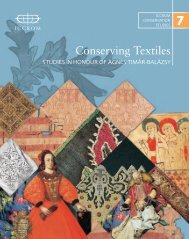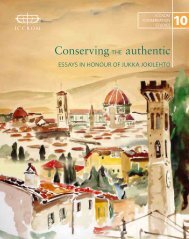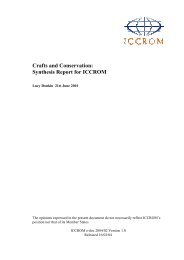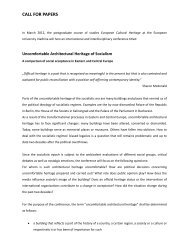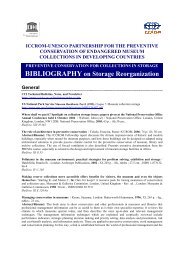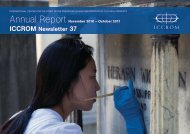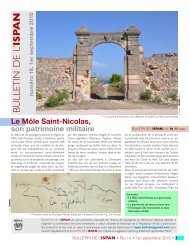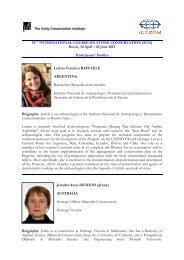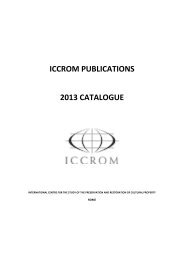part 1 - Iccrom
part 1 - Iccrom
part 1 - Iccrom
Create successful ePaper yourself
Turn your PDF publications into a flip-book with our unique Google optimized e-Paper software.
MEASURING HERITAGE CONSERVATION PERFORMANCE<br />
6th International Seminar on Urban Conservation<br />
Figure 1. The Garden of Delights, Hieronymus Bosch, 1504. Oil on wood. Museo del Prado, Madrid, Spain (Source: http: //<br />
homepage.mac.com/kennyneal/jei/050825bosch01.jpg).<br />
1950s, which were inventoried to be provided as<br />
historic gardens. The ability to ensure its conservation<br />
lies in developing a system of indicators which<br />
must be evaluated for authenticity and integrity.<br />
Concerning the inclusion of living beings in its<br />
composition, garden conservation adds to the complexity<br />
of life. This is explicit in the Charter of Florence<br />
(1981), which describes the garden as a monument,<br />
an architectural composition whose main material<br />
is the plant: alive, perishable and renewable. These<br />
living elements of the garden are one of the main<br />
subjects of discussion of the spirit of the place and<br />
seem indispensable for that character of vitality. The<br />
spirit of the place, as the Declaration of Québec (2008)<br />
states, “offers a broader understanding of character<br />
alive, while permanent of the monuments, sites and<br />
cultural landscapes”.<br />
1. The significance of the garden<br />
and the historic garden<br />
In a poetic and spiritual sense, reference to the<br />
garden is formed from metaphors associated with<br />
memories, nostalgia, joy, beauty, colours, flowers,<br />
birds, shadows, light, childhood and fantasy. Nevertheless,<br />
be nature transformed into fireworks and<br />
still ‘nature alive’, it has its own existence, because<br />
it carries these metaphors full of symbols and meanings<br />
that reflect the aesthetic taste of an era, representing<br />
the ideals and aspirations of man and situated<br />
in space and time.<br />
From a semantic point of view, more than any<br />
other historical or cultural heritage type, the garden<br />
brings forth the essence of its constituent<br />
nature: culture and biophysical components such as<br />
vegetation, terrain, soil, water, climate; that is, life;<br />
and the support on which life manifests itself. Take<br />
as its essence the randomness of life, understood as<br />
a continuous process of exchanges and relationships<br />
that manifest, above all, as the possibility to awaken<br />
all the senses because it is among the artistic manifestations<br />
that challenge our sensory systems;<br />
“In principle, gardens are pleasant to the eyes;<br />
the sound of leaves in the wind, source or bird<br />
attracts our ears; the smell of flowers and herbs<br />
attracts our smell; the taste of fruit flatters our<br />
palate and the velvet softness of a fruit or a<br />
flower produces pleasant tactile sensations. It is<br />
possible to add to this set of perceptions that the<br />
drawing of the entire attracts our intellect and<br />
awakens a deep admiration” (Moreno, 1988, p.<br />
312).<br />
When referring to garden, Moreno refers to its<br />
origins pertaining more to the creation of promised<br />
paradise, exposing the possibilities of happiness<br />
offered by Divine Providence through nature. The<br />
strength of fantasy of the Hieronymus Bosch triptych<br />
“The Garden of Delights”, reveals the history of<br />
the world from creation, told in panels depicting the<br />
‘Garden of Eden’, the ‘Garden of Earthly Delights’<br />
and ‘Hell’ (Zorrilla, 2000), Figure 1.<br />
Between heaven and hell, between good and evil,<br />
lies the earthly life full of lust in the utopia of Bosch.<br />
These gardens of human life reveal symbolically the<br />
relationships established at the moment of creation,<br />
and the organized nature of the pictorial composition<br />
of the environment necessary to understand the<br />
narrative. In this structure, united by the same horizon<br />
and luminosity, heaven and earth differ from<br />
hell, bleak and hopeless. These symbolic character<br />
Carneiro, A. R. S.; da Silva, J. M.; Veras, L. M. de S. & A. de F. Silva. 2012. The complexity of historic garden life conservation.<br />
In Zancheti, S. M. & K. Similä, eds. Measuring heritage conservation performance, pp. 33-41. Rome, ICCROM.<br />
34



